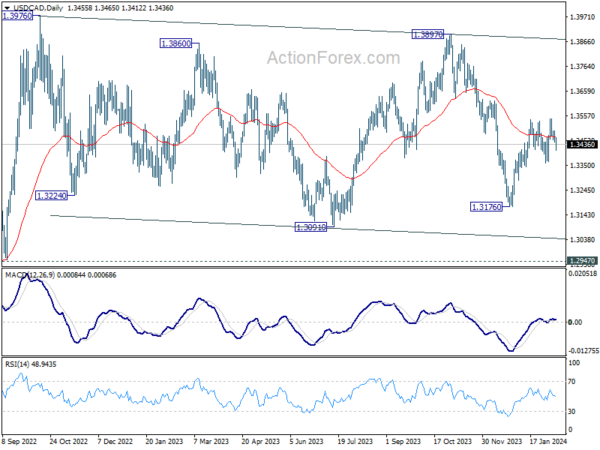Canadian Dollar bounces broadly in early US session, bolstered by unexpectedly robust Canadian employment data. This development comes amidst cautious remarks earlier in the week from BoC Governor Tiff Macklem, who tempered expectations by noting that achieving the 2% inflation target would be a gradual process, fraught with persistent risks. The January meeting minutes echoed this sentiment, highlighting concerns over the potential for enduring inflationary pressures and the dangers associated with prematurely easing monetary policy. Today’s employment figures would likely provide BoC’s more hawkish members with additional justification for maintaining a cautious stance on monetary adjustments.
The broader currency market is also reacting to a mild uptick in risk sentiment, which appears to be favoring commodity currencies at large. New Zealand Dollar is currently leading the pack, buoyed by ANZ’s forecast that RBNZ will deliver rate hikes in both February and April. Australian Dollar is having a moderate increase as well, albeit at a slower pace compared to its counterparts.
The general trend towards strength in commodity currencies contrasts with the ongoing weakness observed in the Swiss Franc and Japanese Yen. Meanwhile, Dollar, Euro, and Sterling are continuing their range-bound trading patterns, reflecting a period of extended consolidation.
In Europe, at the time of writing, FTSE is up 0.15%. DAX is up 0.13%. CAC is up 0.02%. UK 10-year yield is down -0.0038 at 0.4048. Germany 10-year yield is down -0.0011 at 0.2356. Earlier in Asia, Nikkei rose 0.09%. Hong Kong HSI fell -0.83%. Singapore Strait Times fell -0.15%. Japan 10-year JGB yield rose 0.0253 to 0.724.
Canada’s employment rises 37k in Jan, unemployment down to 4.7%
Canada’s employment grew strongly by 37k in January, well above expectation of 35k.
Unemployment rate fell -0.1% to 5.7%, the first decline since December 2022, and below expectation of a rise to 5.9%. Participation rate fell -0.2% to 65.3%.
Employment rate fell -0.1% to 61.6%, as population growth (+0.4%) outpaced employment growth (+0.2%).
Average hourly wages rose 5.3% yoy, slowed from prior month’s 5.4% yoy.
ECB’s Kazaks: Summer the moment for rate cut, not Spring
ECB Governing Council member Martins Kazaks provided a tempered outlook on the prospects of interest rate reductions within Eurozone, cautioning against premature expectations for cuts as early as spring. In an interview with Latvijas Radio, Kazaks outlined his stance on the timing and conditions necessary for beginning to ease ECB’s monetary policy stance.
“At the moment, there are expectations that the rates could be cut in the spring, in March or April — I wouldn’t be optimistic,” Kazaks stated. He advocates for a patient and data-driven approach, emphasizing the importance of ensuring that inflation trends are firmly under control before considering rate reductions.
“I would be cautious and I would wait until the inflation story is over. Then we can safely breathe and those rates can be lowered step by step,” he elaborated.
Looking ahead, Kazaks indicated “Summer could be that moment”. However, he cautioned that would depend on incoming data. “If nothing negative happens, that pushes up inflation and geopolitical risks, if nothing like that happens then this will be the year that rates start to be lowered,” he added.
ECB’s Villeroy confident in Eurozone’s path to overcoming inflation sickness
ECB Governing Council member Francois Villeroy de Galhau, in an interview with LCI television, anticipates reducing interest rates within the year, marking a significant move away from the aggressive inflation-fighting measures.
“We will probably cut rates this year because we are making progress against inflation,” Villeroy stated.
“We are exiting the emergency of fighting inflation and are on the right path to overcome the sickness,” he elaborated.
Further bolstering this positive outlook, Villeroy projected gradual acceleration in economic growth in France in the coming months, fueled by decline in inflation rates that is expected to fall below pace of wage increases.
Bank of France’s forecast, as mentioned by Villeroy, anticipates avoiding a recession, with an expected expansion rate of about 0.9% for the year.
BoE’s Haskel defends focus on inflation persistence without regret
BoE MPC member Jonathan Haskel emphasized the importance of caution when interpreting UK’s recent decline in headline inflation to 4% in December. While acknowledging this positive trend, he stressed the necessity of focusing on more enduring aspects of inflation.
“I’m not going to apologize for banging on about persistence because I think we’re right to,” he asserted. Particularly concerning to Haskel are the underlying measures of price growth, especially within the services sector. Despite the headline inflation drop, these measures have recently plateaued at an annual rate of approximately 6.5%, a level Haskel considers still too high.
“The signs that we’ve seen thus far are encouraging. I don’t think we’ve seen quite enough signs yet,” Haskel remarked. “But if we accumulate more evidence on persistence, then by the very logic I’ve just set out, I’d be happy to change my vote.”
Haskel, who supported another rate hike in the last MPC meeting, described his decision as “finely balanced,” highlighting his desire for more time to assess the inflationary trend’s durability.
RBA’s Bullock: Another hike neither ruled out nor ruled in
In an appearance before a parliamentary economics committee in Canberra today, RBA Governor Michele Bullock acknowledged the presence of “some encouraging signs” in Australia’s economic landscape, yet cautioned that the nation’s battle against inflation is “not over”.
RBA’s stance remains deliberately balanced, with Bullock stating, “At this stage, the Board hasn’t ruled out a further increase in interest rates but neither has it ruled it in.” Interest rate path will “depend upon the data and the evolving assessment of risks”.
Bullock further elaborated on the dynamics of demand and supply within the Australian economy, indicating that demand levels continue to outstrip the economy’s supply capacity. This imbalance, coupled with persistently tight labor market conditions, suggests that while the observed slowdown in demand is contributing to a moderation of inflationary pressures, the desired equilibrium has yet to be reached.
Goods price inflation has shown a softer trend than anticipated, mirroring patterns observed in international markets, Bullock noted. However, services price inflation remains elevated, driven by significant increases in both labor and non-labor input costs.
“Indeed, while inflation was lower than we were expecting in November, this is largely attributable to softer-than-expected goods inflation – services inflation was pretty much where we had forecast it to be.”
ANZ forecasts RBNZ rate hikes, triggering Kiwi surge and AUD/NZD range breakout
New Zealand Dollar rises broadly today, buoyed by ANZ’s forecast that RBNZ is set to increase the official cash rate in its upcoming meetings on February 22 and again in April, elevating interest rate to 6%.
ANZ’s chief economist, Sharon Zollner, highlighted RBNZ’s November warning that stronger-than-expected inflation pressures would necessitate further increases in the OCR.
“Data since then has been a series of small but pretty consistent surprises in that direction,” Zollner noted. The economist further elaborated that the cumulative effect of these data surprises, though individually not game-changers, collectively strengthens the argument for the RBNZ to proceed with rate increases.
“Indeed, their OCR forecast peak of 5.69% implied that the burden of proof was now on finding reasons not to hike, strictly speaking,” Zollner added.
In the currency markets, AUD/NZD’s steep decline and strong break of 1.0658 support affirms the bearish case that consolidation from 1.0469 has completed at 1.0942 already. Outlook will stay bearish as long as 1.0691 support turned resistance holds. Next target is retest of 1.0469 (2022 low).
Decisive break of 1.0469 will resume whole down trend from 1.1489 (2022 high), and pave the way to 61.8% projection of 1.1489 to 1.0469 from 1.0942 at 1.0312 in the medium term.
USD/CAD Mid-Day Outlook
Daily Pivots: (S1) 1.3440; (P) 1.3467; (R1) 1.3485; More…
USD/CAD dips notably in early US session but stays well above 1.3357 support. Intraday bias remains neutral first and further rally is in favor. On the upside, decisive break of 1.3540/3 will resume the rise from 1.3176. That will also revive that case that whole fall from 1.3897 has completed, and target this resistance. Nevertheless, firm break of 1.3357 support will argue that rebound from 1.3176 has completed, and target this low for resuming whole fall from 1.3897.
In the bigger picture, price actions from 1.3976 (2022 high) are viewed as a corrective pattern only. In case of another fall, strong support should emerge above 1.2947 resistance turned support to bring rebound. Overall, larger up trend from 1.2005 (2021 low) is still expected to resume through 1.3976 at a later stage.
Economic Indicators Update
| GMT | Ccy | Events | Actual | Forecast | Previous | Revised |
|---|---|---|---|---|---|---|
| 23:50 | JPY | Money Supply M2+CD Y/Y Jan | 2.40% | 2.20% | 2.30% | |
| 07:00 | EUR | Germany CPI M/M Jan F | 0.20% | 0.20% | 0.20% | |
| 07:00 | EUR | Germany CPI Y/Y Jan F | 2.90% | 2.90% | 2.90% | |
| 09:00 | EUR | Italy Industrial Output M/M Dec | 1.10% | 0.50% | -1.50% | -1.30% |
| 13:30 | CAD | Net Change in Employment Jan | 37.3K | 15.0K | 0.1K | |
| 13:30 | CAD | Unemployment Rate Jan | 5.70% | 5.90% | 5.80% |














